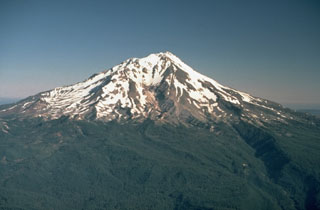Report on Shasta (United States) — July 1978
Scientific Event Alert Network Bulletin, vol. 3, no. 7 (July 1978)
Managing Editor: David Squires.
Shasta (United States) Earthquake swarm; maximum M 4.2
Please cite this report as:
Global Volcanism Program, 1978. Report on Shasta (United States) (Squires, D., ed.). Scientific Event Alert Network Bulletin, 3:7. Smithsonian Institution. https://doi.org/10.5479/si.GVP.SEAN197807-323010
Shasta
United States
41.409°N, 122.193°W; summit elev. 4317 m
All times are local (unless otherwise noted)
An earthquake swarm in the vicinity of Mt. Shasta began at 0202 on 1 August. The first event, M 4.2, was followed by six M 3-4 events in the next 45 minutes. Between 35 and 40 shocks (M greater than or equal to 2) were recorded on 1 August. The number of events declined slightly the next day and only about ten had been recorded by midday on 3 August. About 20 of the total had M greater than or equal to 3. Permanent seismographs were too distant for precise hypocenter determinations, but USGS personnel were bringing portable seismographs into the area.
An ash eruption, probably from Shasta, was sighted from a ship off the California coast in 1786.
Geological Summary. The most voluminous of the Cascade volcanoes, northern California's Mount Shasta is a massive compound stratovolcano composed of at least four main edifices constructed over a period of at least 590,000 years. An older edifice was destroyed by a large debris avalanche which filled the Shasta River valley to the NW. The Hotlum cone, forming the present summit, the Shastina lava dome complex, and the SW flank Black Butte lava dome, were constructed during the early Holocene. Eruptions from these vents have produced pyroclastic flows and mudflows that affected areas as far as 20 km from the summit. Eruptions from Hotlum cone continued throughout the Holocene.
Information Contacts: R. Lester, USGS, Menlo Park, CA.

